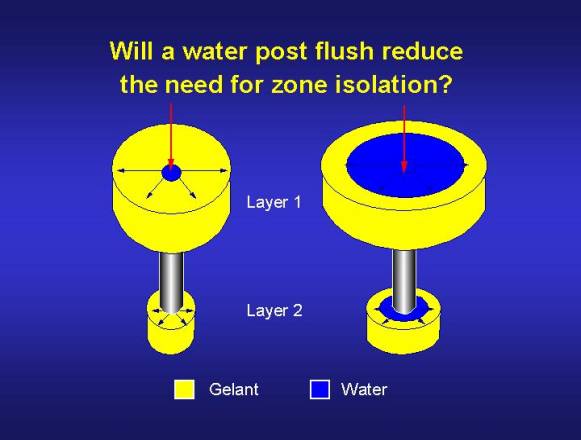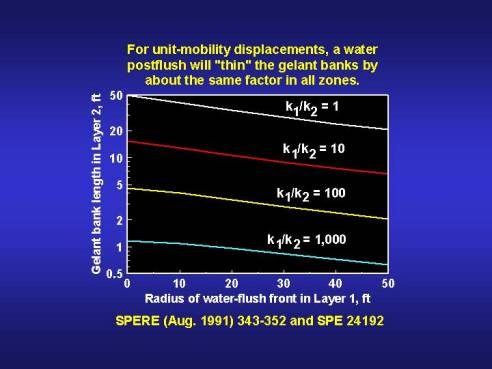In Systems Without the Potential for Crossflow, Can a More Selective Gel Placement Be Achieved by Injecting a Water-Like Gelant Followed by a Water Postflush?
(No.)
Additional mixing and thinning of gelant banks can be induced by injecting water to displace gelants away from the wellbore prior to gelation. The impact of a water postflush will be considered in two parts. In this section, the discussion will focus on displacement of a water-like gelant (Fr=1) by injection of water. The next section will discuss the case where water displaces a viscous gelant.
If water is injected to displace a water-like gelant, the mobility ratio for the displacement is unity. In radial flow, injection of a water postflush will thin the gelant bank, even in the absence of diffusion and dispersion (see Fig. 15). However, this thinning is not large, and it occurs to about the same proportion in all zones. This point is illustrated in Fig. 16. The situation represented in Fig. 16 is as follows. First, a water-like gelant is injected into a radial, multilayer reservoir until the gelant propagates to a radius of 50 ft in the most-permeable layer (Layer 1). (The wellbore radius is 0.5 ft, and all layers have the same porosity.) At this time the length of the gelant bank (bank radius minus the wellbore radius) will be 49.5 ft, 15.3 ft, 4.5 ft, and 1.2 ft in layers that have permeabilities that are 1, 10, 100, and 1000 times less than that in the most-permeable layer, respectively. After injection of the gelant, water is injected to displace the gelant away from the wellbore. Fig. 16 plots the length of the gelant bank in a given zone (Layer 2, where the permeability ratio, k1/k2, is specified in the figure) as a function of radius of the water postflush in the most-permeable zone. Fig. 16 reveals that a water postflush out to 50 ft in the most-permeable zone reduces the length of the gelant bank in all zones by roughly a factor of two.
Ref. 42 presents a detailed examination of the impact of bank thinning, dispersion, and diffusion on gelant placement when a water postflush displaces a water-like gelant away from the wellbore before gelation. From that analysis, we concluded that a water postflush prior to gelation can significantly increase injectivity in a radial geometry. Unfortunately, injectivity increases by approximately the same proportion in all zones. Also, diffusion and dispersion can reduce the size of a gel bank during a water postflush. However, the bank size is reduced by about the same proportion in all zones. Thus, a water postflush usually does not help to eliminate the need to protect hydrocarbon-productive zones during gel placement.

